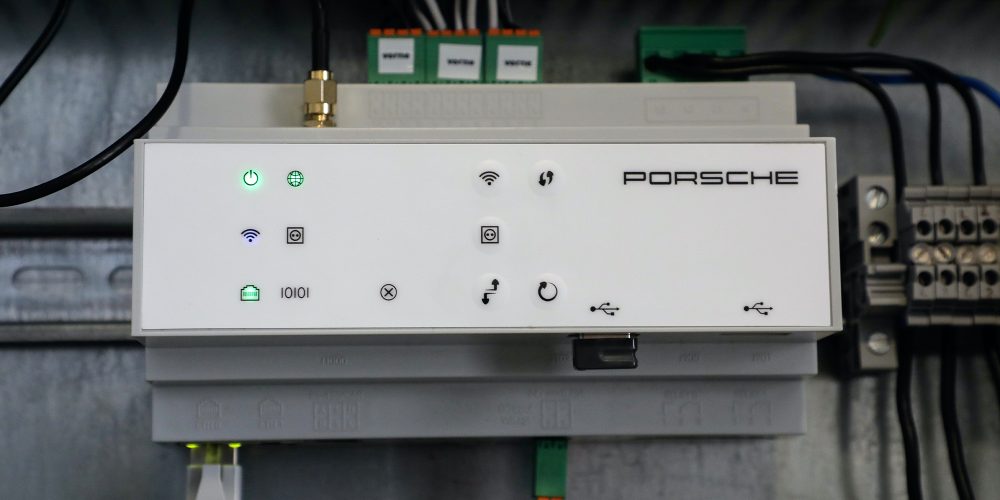
Porsche AG is testing the possibilities of vehicle-to-grid (V2G) technology in its EVs, but taking it a step further. Rather than just deliver EVs like the Taycan that can supply energy back to the grid rather than just pull from it, Porsche has run a V2G pilot program that utilizes “swarms” of EVs whose high-voltage batteries are pooled to help keep the local electrical grid stabilized.
Bi-directional charging is a technological feature in which an EV can not only receive energy from an electrical source, but also send it back out where needed. Since it remains a relatively new concept, not all automakers have integrated bi-directional capabilities into their EVs yet.
For example, the new IONIQ 5 has bi-directional capabilities that support vehicle-to-load (V2L) functions. This means the EV can be used as a battery storage pack to power outside devices such as a TV, mini fridge, or even charge other EVs.
Ford’s highly anticipated F-150 Lightning pickup has bi-directional capabilities, in that it can use its spare energy to power your home and appliances when connected to a charger, should a power outage or natural disaster occur… or if energy rates are simply too high during peak hours.
In terms of supplying energy back to the grid, commercial vehicles are by far leading the way. Last mile delivery fleets and electric school buses in particular are quickly being integrated with V2G capabilities to supply energy back to the grid during peak energy hours, when the vehicles are not in operation.
The process itself represents a new way that we can optimize energy usage on our grid without having to rely on power plants as backup sources for constant stability. Through a recent pilot program, Porsche has proven that V2G technology is a feasible and effective solution in supporting the grids its EVs are connected to.

Porsche pilot program proves benefits of V2G tech in its EVs
The German automaker recently shared a press release outlining details of its vehicle-to-grid pilot program using a “swarm” of five Taycan EVs and its Home Energy Manager (HEM). Together with the help of grid operator TransnetBW, Porsche tested the balancing power of the series-production Taycans connected to the HEM in realistic domestic and laboratory conditions.
The results proved positive for Porsche, who foresees a future of more EVs with V2G capabilities. Lutz Meschke, Deputy Chairman of the Executive Board of Porsche AG elaborated:
The charging technology of the Porsche Taycan and our Home Energy Manager and Mobile Charger products have a lot of potential for the future: the pilot test proved that. And the balancing power market isn’t the only thing a pooling system of this kind can be used for. Advanced solutions for green charging and other vehicle-to-grid applications are also conceivable. And that’s not all: if electric vehicles feed electrical energy back into the grid in the future for example with a private photovoltaic system, contributing to the expansion of regenerative energy, it will further increase the acceptance of e-mobility.

Porsche points out that under current energy infrastructure, the grid must remain stable at a constant 50 Hertz power frequency to avoid risk of power outages. However, renewable energy sources such as wind and solar are not always producing consistent amounts of energy, so conventional power plants are currently responsible for delivering necessary power to supplement these fluctuations.
With widespread integration of V2G tech in electric vehicles that include Porsche and beyond, high-voltage batteries can be pooled together to back up renewables instead of power plants, while simultaneously giving car owners the potential for passive income by selling their EVs energy back to the grid. In a broad sense, this is a win-win for all parties.
While widespread adoption of V2G charging across all EVs will take some time, Porsche has provided further evidence that its benefits truly could serve consumers and energy companies, as well as the overall environment. Dr Rainer Pflaum, CFO at TransnetBW spoke:
A real measurable milestone: the project team has managed to implement the complex communication infrastructure between our control system and several electric vehicles. At the same time, the strict specifications for storing and supplying balancing power have been met. This will enable us to integrate electromobility into the intelligent power grid of the future.
It unclear exactly when drivers may see their Porsche with V2G capabilities, but the automaker seems quite high on the prospect of widespread adoption and will certainly continue to explore its potential.
Subscribe to Electrek on YouTube for exclusive videos and subscribe to the podcast.
Author: Scooter Doll
Source: Electrek



